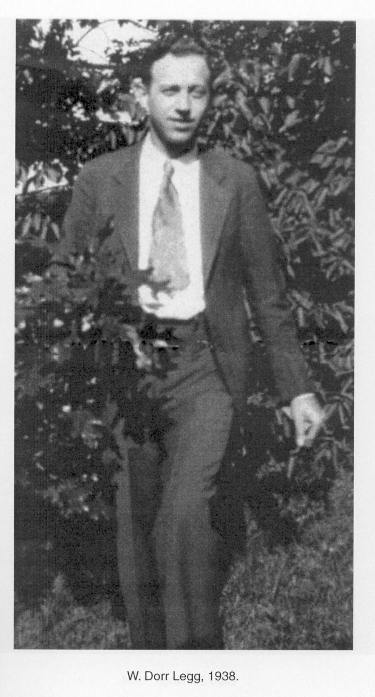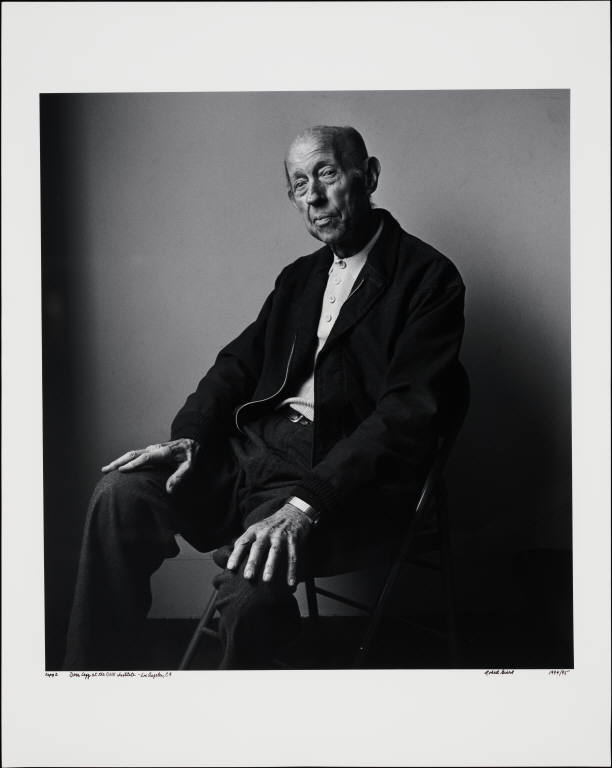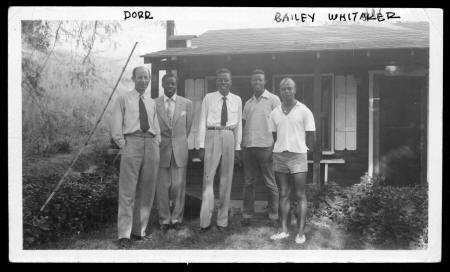

Partner John Nojima
Queer Places:
University of Michigan, Ann Arbor, Michigan, Stati Uniti
Forest Lawn Memorial-Parks & Mortuaries, 6300 Forest Lawn Dr, Los Angeles, CA 90068, Stati Uniti
 William Dorr Legg (December 15, 1904 - July 26, 1994), second son of Franc C. Dorr and Frank E. Legg, was born
in his mother's family home, 406 Maynard Street, Ann Arbor, Michigan on
December 15, 1904. Circa 1910, the family purchased a small farm three miles
outside of Ann Arbor on the interurban streetcar line. According to his
interviews, the whole family shared the responsibilities for care of animals
and the household. On Sunday afternoons visitors from the University of
Michigan and family friends would provide lively national and international
political discussions in exchange for music and "good country" cooking. These
afternoon discussions exposed Legg to a variety of ideas and people, including
"emancipated women."
William Dorr Legg (December 15, 1904 - July 26, 1994), second son of Franc C. Dorr and Frank E. Legg, was born
in his mother's family home, 406 Maynard Street, Ann Arbor, Michigan on
December 15, 1904. Circa 1910, the family purchased a small farm three miles
outside of Ann Arbor on the interurban streetcar line. According to his
interviews, the whole family shared the responsibilities for care of animals
and the household. On Sunday afternoons visitors from the University of
Michigan and family friends would provide lively national and international
political discussions in exchange for music and "good country" cooking. These
afternoon discussions exposed Legg to a variety of ideas and people, including
"emancipated women."
His formal education began at the Stone Schoolhouse, a single room for eight grades. At the age of ten or eleven his father instructed him on the finer points of collecting rent from the tenants of their family-owned properties. He started college at the age of 16, commuting on the streetcar line to the University of Michigan, where the diverse University Library collection expanded his knowledge of the world. In 1924, the family planned to winter in Broward County, Flordia. In Orlando, while on the journey, Legg had his first "homophile" experience with an older gentleman, he picked up in a park. That winter in the midst of the Florida land boom, he found a position as a landscape designer in Tampa. During the day he worked for the Florida Landscape Eng. Company and during the evenings and weekends he enjoyed the social life of Tampa.
He returned to the University of Michigan and graduated with his Bachelor of Arts degree from the College of Literature Science and the Arts in November 1926. He continued his education simultaneously enrolling in a music program at the University School of Music, Ann Arbor and a landscape design program at the University of Michigan. (In 1940, the University Musical Society transferred all responsibilities for University Music School program to the University of Michigan.) In 1928, he simultaneously graduated from both programs and received a scholarship for the summer program at the Foundation for Architecture and Landscape Architecture in Lake Forest, Illinois. He subsequently left for New York City where he experienced the city's cultural and social life including the tail end of the Harlem Renaissance. Employed as a landscape architect, he worked in the city and later moved to the bedroom community of White Plains, New York. In 1933, he became a member of the White Plains' Church of Christian, Scientist where he served on the Church Board and as Chairman of the Lecture Committee through 1935.

Featured in
Particular Voices: Portraits of Gay
and Lesbian Writers by Robert Giard [Rights Notice: Copyright Jonathan G. Silin
(jsilin@optonline.net)]

W. Dorr Legg (left) standing next to Bailey Whitaker and others, undated. Credit: ONE Archives at the USC Libraries. ONE got its name from a quote from the 19th century Scottish philosopher Thomas Carlyle. The quote reads, “A mystic bond of brotherhood makes all men one.” Dorr Legg credited Guy Rousseau, an African American school teacher whose real name was Bailey Whitaker, with finding the quote and suggesting the name.
A classmate from the Foundation for Architecture and Landscape Architecture program had obtained a position at Oregon State College (OSC) and encouraged Legg to apply for a position. Legg was hired by OSC and from 1936 to 1942 he served as an assistant professor of landscape design. In his final year, he also served as an assistant professor of art and architecture. While at OSC he continued his landscape design practice, instituted a Christain Scientist student organization and contributed the founding of a Christain Scientist church in Corvallis. He also hosted a gardening program on the college radio station, established a local chapter of the professional landscape architects organization, created a committee to maintain and beautify the campus, and contributed articles to various professional journals and popular magazines.
By 1943, enrollment had decreased significantly and Legg's brother, who had assisted their father in the family business, joined the war effort. Legg returned to Michigan to manage the family business and his father's affairs until his father's death in 1949. In the same year, he was arrested and plead guilty to a charge of "gross indecency;" Legg's socializing with African-American men had drawn the attention of the police. As a result of his arrest, he was almost evicted from his apartment and was suspended from the Church of Christ, Scientist.
Seeking a more progressive and tolerant community, he relocated to Los Angeles. From September 1949 to January 1951, Legg operated the Dorr School of Design, where he taught art, architecture, interior design, and landscape design classes "the Dorr way." During this time Legg and his partner, Merton Byrd formed "The Knights of Clocks," an interracial couples community organization with the goal of providing counseling services, legal advice, and hosting social affairs. In 1951, he met like-spirited individuals that knew of a secret organization, The Mattachine Society.
On October 15, 1952, at a regular Mattachine Guild meeting, a few members brought forth the concept of an organizational voice. This idea was outside of the agenda and members interested in further discussion were asked to adjourn to the kitchen. That evening the concept of a homosexual magazine was conceived and over the next two months a new organization, ONE, Incorporated was formed. In January 1953, the first issues were sold for 25 cents each, the same price as a beer at the time. By April 1953, the magazine offered the opportunity of full-time employment for Legg as Business Manager and an occasional weekly pay check of $25.00. He wrote articles under a number of pseudonyms including; Holister Barnes, Richard Conger, Marvin Cutler, W.G. Hamilton, William Lambert, Wendy Lane, Valentine Richardson, and Sidney Rothman.
Legg believed that education could be transformative in gaining society's acceptance of gays and lesbians. In 1956, he championed the establishment of The Institute of Homophile Studies, the first institute in the United States dedicated to the study of homosexuality. The Institute proved a range of educational opportunities and received state accreditation for a period during the 1980s. Using his pseudonym, Marvin Cutler, as editor, ONE, Inc. published, Homosexuals Today: A Handbook of Organizations and Publications . Legg and the editor of ONE Magazine , Don Slater, struggled over the future direction of the organization in 1965. Legg's faction won the right to continue using the name "ONE" in 1967. During this time, Legg contributed to the founding of the Southern California Council of Religion and the Homophile (SCCRH) in 1966, an organization formed to improve relations with mainstream religions and address the spiritual needs of the gay and lesbian community. In 1976, Vern Bullough, Barrett W. Elcano, W. Dorr Legg, and James Kepner published their edited work the Annotated Bibliography of Homosexuality , a survey of gay and lesbian literature. The following year, Legg contributed to the founding of the "Lincoln Republicans," which became the Log Cabin Club. A ballot intiative to ban public school employment of gays, lesbians, and possibly anyone that supported gay rights had spurred the formation of the organization. Legg's final collaboration in publishing was a history of ONE Institute and its educational efforts with David G. Cameron and Walter L. Williams, Homophile Studies in Theory and Practice .
In 1960 Legg and John Nojima had started dating and they remained together until Legg's death in 1994. Nojima played a key role in supporting Legg financially and recording many ONE events. Legg died in their home in his sleep on July 26, 1994.
My published books: